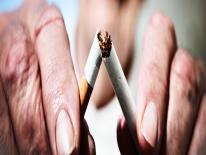
Tobacco use is the #1 cause of death that could be prevented. Tobacco use and smoking can cause heart disease, stroke, asthma and other respiratory (breathing) illnesses, dementia, high blood pressure, diabetes, and many types of cancer including cancers of the lung, esophagus, mouth, stomach, colon and rectum, female cervix, kidneys, bladder, liver, and pancreas. Smoking during pregnancy can cause premature birth or low birthweight of the baby and is linked to birth defects. Secondhand smoke, smoke you breath in when you are near someone else who is smoking, can cause many of the same diseases and conditions.
Tobacco can be used in many forms. Combustible tobacco products, tobacco that is lighted and burns, include cigarettes, pipes, cigars, little cigars, and cigarillos. Noncombustible tobacco products, tobacco that is heated in a device but does not burn, include electronic cigarettes (e-cigarettes) and vapes. Smokeless tobacco is tobacco that can be chewed. It does not matter what kind of tobacco product a person uses. All forms of tobacco can affect your health.
It is best not to start smoking, because once a person starts smoking, it can be very hard to quit. This is because nicotine, a chemical in tobacco, is very addictive. If you do smoke, even if you have smoked for many years, quitting can improve your health. It can take more than one attempt to quit smoking to stop smoking for good. There are many services to help people stop smoking.
Tips for Quitting Smoking
- Make a plan to quit. Setting a “quit date” can give you a goal.
- Ask your friends and family for support.
- Avoid people, places, and things that encourage you to smoke. This might mean changing some of your daily routines, such as taking a break from work where you can smoke.
- Stay busy. If you feel the urge to smoke, find other things to do, such as go for a walk, call a friend, engage in a favorite hobby, or drink a glass of water.
- Talk to your doctor about quitting. There are medications like nicotine replacement therapy (NRT) that can decrease how much you want to smoke. NRT comes in many forms such as patches, lozenges, and gum. There are also other medications, called non-NRT medications, that can help you quit. Your doctor may refer you to other resources, such as a group that supports each other in quitting. Most health insurance plans cover NRT, other medications, and counseling to help smokers quit.
- Contact DCQuitNow, a service provided at no-cost to help smokers quit. DCQuitNow offers counseling and other support services such as text messaging and NRT. Call 1-800-QUIT-NOW (1-800-784-8669) or visit dcquitnow.com.
- Visit https://www.cdc.gov/tobacco/campaign/tips/quit-smoking/index.html for more tips and tools to help you stop smoking.
Smoke-free Places
Washington, DC has laws and regulations in place to protect good health. This includes designating spaces parks, recreational facilities and football stadiums, and workplaces as smoke-free to reduce exposure to secondhand smoke. The US Department of Housing and Urban Development (HUD) and the DC Housing Authority banned smoking in all public housing beginning in 2018.
If you live in other multi-unit housing, like an apartment building or a condominium, that is not smoke-free, you could be exposed to secondhand smoke even if no one in your unit smokes. There are many resources available to help you support a smoke-free building. Visit American Lung Association or American Nonsmokers’ Rights Foundation for more information and tools.
- በዚህ ገጽ ላይ የተተረጎሙ መረጃዎችን በአማርኛ ማግኘት ይችላሉ።
- 請在此處查找本頁信息的中文翻譯。
- Veuillez trouver une traduction française des informations sur cette page ici.
- 여기에서 이 페이지의 정보에 대한 한국어 번역을 찾으십시오.
- Encuentre una traducción en español de la información en esta página aquí.
- Vui lòng tìm bản dịch tiếng Việt của thông tin trên trang này tại đây.
